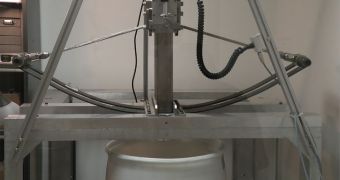Experts at the American space agency are hard at work towards developing a type of harpoon that would enable future robotic spacecraft to rapidly and precisely collect samples from the surface of comets, without having to land on their surface.
This would be an important step forward, since comets are not the easiest objects to study up close. They have a tendency to spew out large chunks of rocks and ice, not to mention gases, dust and water vapors. On top of it all, the objects travel at speeds up to 150,000 miles (241.4 kilometers) per hour.
Therefore, landing on such a dangerous target would entail a very high probability of the spacecraft being lost. As no one wants that, researchers started thinking about alternative solutions to collecting samples some time ago.
A harpoon seems to be the best and most feasible idea thus far. The idea is to match the speed of a robotic explorer with that of the object being targeted. In effect, the probe would appear to be hovering above the surface of the comet.
From this position, a harpoon would be fired in rapid succession at designated areas, collecting samples, and then returning them to the spacecraft, for storage. This could be done multiple times, until the probe's storage chambers are full.
Experts at the NASA Goddard Space Flight Center (GSFC), in Greenbelt, Maryland are well on their way towards creating such an instrument. The metal ballista they've already developed can fire projectiles at speeds exceeding 100 feet (30 meters) per second.
The 6-foot (1.80-meter) crossbow is made up of a pair of truck leaf springs. Its string is a half-inch-thick steel cable, which is being pulled back by a large electric winch. The entire instrument is about the size of a large closet.
“We had to bolt it to the floor, because the recoil made the whole testbed jump after every shot. We're not sure what we'll encounter on the comet – the surface could be soft and fluffy, mostly made up of dust, or it could be ice mixed with pebbles, or even solid rock,” GSFC led engineer Donald Wegel says.
“Most likely, there will be areas with different compositions, so we need to design a harpoon that's capable of penetrating a reasonable range of materials. The immediate goal though, is to correlate how much energy is required to penetrate different depths in different materials,” he explains.
“What harpoon tip geometries penetrate specific materials best? How does the harpoon mass and cross section affect penetration? The ballista allows us to safely collect this data and use it to size the cannon that will be used on the actual mission,” he concludes.

 14 DAY TRIAL //
14 DAY TRIAL //